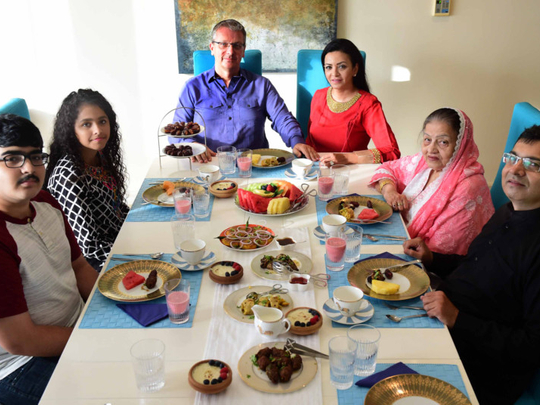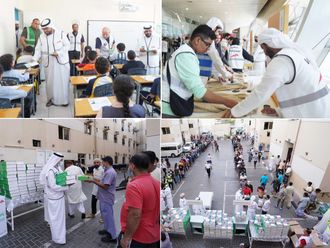
Dubai: The excitement was palpable in the Palm Jumeirah home of Dr Sobia Khan and her husband Christian Kruppa for the first iftar of Ramadan. Daughter Parisa, 14, and nephew Mizan, 17, laid out the crockery, and got sweetened, rose-flavoured milk ready even as the spicy aromas of special lamb cutlets and grilled chicken wafted across to the dining room.
Dr Khan, a non-practising medical doctor, Kathak danseuse [an Indian classical dance form] and home-maker, lives with her German husband Kruppa, an oil and gas entrepreneuer, her children Parisa, Justin, 19, and step-daughters, Sophia and Marisa, offering a poster example of harmony and togetherness.
As iftar approaches, Dr Khan lays out the home-made food, and her mother Begum Feroza reminisces about the times gone by in the town of Nagpur in central India when the advent of Ramadan marked a time of bonding with the community. “The town crier would carry a long staff with little bells attached to one end, proclaiming at the crack of dawn: “Utho Allah ke Bande [Arise children of Allah] Namazon ke din aur Sehri ki Raat [Spend your days offering prayers and nights for suhour]. Ramadan was a magic month for the town where extended families prayed together and women would cook together in the evenings for iftar and suhour,” she recalled.
Dr Khan also has cherished memories of iftar in India. Uncles, aunts, cousins, all would gather. “Ramadan was a special time for family bonding, prayers and charity for us as children. The last hours of fasting were always filled with activity as we ran around organising the plates and spoons, and reaching dishes to the table. Everything was always prepared fresh for the day. My mother, aunts and even women from the neighbourhood, would get together in the kitchen a couple of hours before iftar to get the curries, cutlets, biryanis, ready for the extended family. Some dishes would be for iftar, some for dinner and suhour. We kids would hang around the kitchen letting the aromas kindle our imagination.”
Many of the dishes on the iftar table for the day were what she relished as a child — with a healthy twist. “I have added chia seeds to the lightly sweetened rose-flavoured milk and some falood, nuts and fresh fruits. The dates are stuffed with dry fruits and the mince meat and chicken dishes are shallow-fried or grilled. I have also added a platter of fruit, hummus and avocado dips. As kids, we would have a few sips of the rose-flavoured milk and eat a couple of dates to break the fast, then clean up and offer namaaz before sitting down for the iftar.”
Kruppa, who loves Indian cuisine, said that, over the years, he has come to enjoy its high spice and chilly quotient. “Unlike other Europeans, I love Indian curries, spices, whole green chillies and look forward to my wife’s imaginative cooking for iftar. Sobia is an excellent cook who takes great pains to prepare the delectable lamb cutlets which she loved as a child. I have come to love these too.”
Munzir Khan, who owns the famous Karim’s restuaurant in Al Barsha, seconded Kruppa’s compliments on his sister’s culinary skills. “My sister Sobia has always been a wonderful cook and can handle huge numbers of people and multiple dishes with elan. She recreates the flavours and spices of our traditional cooking and evokes nostalgia with her food. Our origins can be traced back to the royal family of Hyderabad and most of her cuisine has strong Hyderabadi or Nizami influence. She makes excellent nan–khaliya [a leavened bread dish with lamb curry], potli biryani [rice and lamb cooked with freshly pounded spices tied in a muslin pouch suspended in the pot that slowly infuse their essences into the dish] and a variety of salans [fish and meat in gravy-based dishes]. We always try to have a family iftar as it is also about creating lovely memories for this generation.”
Dr Khan said she tries to bring back the essence of the Ramadans she experienced in her childhood. “I try to recreate the same for my children. I look forward to all my kids being here at the table for iftar. During one of the Ramadan fasts, we go to a labour camp in Dubai Investment Park which has 900 workers and offer them a special home-cooked iftar. My children help in laying out the carpet and the crockery and personally serve the workers and we end the fast with them.”
Recipe of the star dish
Lamb keema cutlets (serves 6)
Ingredients:
½ kg of fresh lamb mince
Freshly hand-pounded spices — black pepper, cinnamon, star anise, cardamom and cumin
Chopped green chillies (depending on the spice level)
1 large onion, finely chopped
1/2 bunch of fresh coriander, fresh mint
1 tbsp grated ginger
½ kg of boiled, peeled and mashed potatoes,
Egg white, beaten, for dipping the cutlets
Salt to taste
Oil, for shallow frying
Method
1. Pound the tender boneless lamb pieces into a coarse mince.
2. Dry roast the spices and grind to a powder with a pestle and mortar.
3. Add the spice mix to the mince.
4. In a pan, add a tablespoon of oil, heat and fry the chopped onions till golden brown.
5. Add the mince, spices, green herbs and ginger to the onions, continue to fry sprinkling a little water to keep the mixture from burning, and cover and cook till mince is done.
6. Using your hands, make a patty of the mashed potato and create a well in the centre of the patty. Place a generous quantity of the spiced mince in the well and close the patty to make a round cutlet.
7. Dip the cutlet in egg batter and shallow fry to a golden brown. Drain on kitchen paper and serve hot with coriander and mint chutney.











